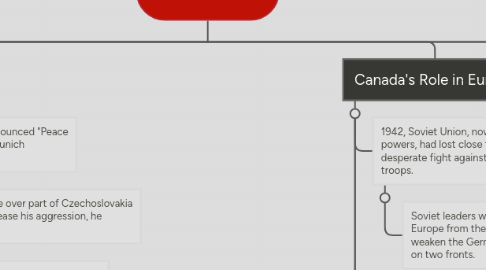
1. The War at Home
1.1. Under the policy of total war, Canadian factories were producing more than ever before.
1.1.1. As in WWI women were mobilized to take men's places, and they began working as welders, drillers, punchpress operators, and machine operators.
1.1.1.1. The provincial government began to provide money for daycare facilities for women with kids. Many workers, especially single women, moved from the rural areas to industrial areas.
1.1.1.1.1. Companies built dormitories to house them close to the factories, and the government helped subsidize the food and rent in the dormitories.
1.2. Canada's Wartime Economy
1.2.1. To avoid inflation, P.M. King chose James Ilsley, a former lawyer, to address the concerns of King.
1.2.1.1. Ilsley encouraged Canadians to buy Victory bonds to help finance the war, he also increased income taxes. He was successful in raising funds for the government but he could not prevent prices from rising.
1.2.1.1.1. 1941, the Wartime prices and Trade Board took the drastic step of freezing all wages and prices.
2. The Tides Turn
2.1. 1942, the tide of the war finally began to turn.
2.1.1. The Allies gained strength when the U.S. entered the conflict in Dec. 1941. They began to win the Battle of the Atlantic and made important advances in the Pacific.
2.1.1.1. By 1943, the Allied forces had cleared North Africa of Axis forces and could turn their attention to the invasion of Europe.
2.2. The Invasion of Italy
2.2.1. British P.M. thought that the best way for the Allies to recapture Europe was through the "soft underbelly" of Europe-Italy and Sicily.
2.2.1.1. July 10, 1943, Canadian soldiers participated in the Allies invasion of Sicily. After 2 weeks if intense fighting they were finally successful.
2.2.1.1.1. In September, the moved to the mainland, Italy. Advances were slow, battles were often fought house by house and street by street.
3. War Declared
3.1. 1938 British P.M announced "Peace for our time" with Munich Agreement.
3.1.1. Let Hitler take over part of Czechoslovakia if he would cease his aggression, he didnt't
3.1.1.1. On September 10th , Canada declared war on Germany.
3.2. Mobilizing Canada's Resources
3.2.1. Canada was not prepared for the war in 1939
3.2.1.1. The had only 4500 soldiers, few dozen anti-tank guns, 16 tanks, and no modern artillery.
3.2.1.1.1. In September over 60,000 people volunteered for service.
3.3. Total War
3.3.1. April 1940, government established the Department of Munitions and Supplies, C.D. Howe was appointed Minister.
3.3.1.1. Howe was given authority to do whatever it took to gear up the economy to meet wartime demands
3.3.1.1.1. He had Vancouver builidning ships for the navy, Montreal constructing new planes, munitions factories opened in Ontario, and car companies started to produce tanks.
4. Canada's Role in Europe
4.1. 1942, Soviet Union, now one of the Allied powers, had lost close to a million soldiers in its desperate fight against invading German troops.
4.1.1. Soviet leaders wanted the Allies to invade Europe from the west, a move that would weaken the German army by forcing it to fight on two fronts.
4.2. The Dieppe Raid
4.2.1. The Allies were not prepared for a full invasion of Europe, but they felt ready for a trial run.
4.2.1.1. A smaller raid would give them an opportunity to test new techniques and equipment, and serve as a reconnaissance ission.
4.2.1.1.1. From the beginning of the raid things went wrong. The morning of August 19, 1942, one of the ships carrying Canadian troops met a Germon convoy. The two ships met in combat. The gunfire alerted the German soldiers on the other side.
4.3. Canadians at Sea
4.3.1. When war broke out, the Royal Canadian Navy rushed into massive building and training program.
4.3.1.1. With only 13 ships 1819 sailors, Canada's navy desperately needed equipment and trained manpower.
4.3.1.1.1. 1941, the Battle of the Atlantic was in full force, and Canada's contribution was much needed.
5. The War in the Pacific
5.1. By 1941 Japan was ready to invade U.S. and European colonies in Southeast Asia, which were rich in resources such as rubber, oil, and tin.
5.1.1. December 7, 1941, Japanese planes bombed the U.S. naval base in Pearl Harbour, destroying half the fleet.
5.1.1.1. The next day the U.S. government declared war on Japan. Japans allies-Germany and Italy-then declared war in the U.S.
5.1.1.1.1. Hours after the bombing of Pearl Harbour, Japanese troops began their surprise invasion of the British colony of Hong Kong. By Christmas Day, 1941, Hong Kong had fallen to the Japanese.
6. The War in Europe
6.1. The Allies ( Britain, France, Commonwealth countries including Canada, Australia, and New Zealand.
6.1.1. The Alliance of Germany, Italy, and Japan became known as the Axis.
6.1.1.1. Allied forces were stationed along Frances border with Germany waiting for Germany's next move. Nothing happened for 7 months, this became known as the "Phoney War."
6.1.1.1.1. The Phoney War spread the illusion that there might not be a war. Germany shattered that idea with "Blitzkrieg", attacking Denmark and Norway in April, 1940.
6.2. Evacuation At Dunkirk
6.2.1. May 10, German armed forces began its invasion of the Netherlands.
6.2.1.1. Within days of arriving in France, German panzers had reached the English Channel.
6.2.1.1.1. The Allied forces were soon surrounded in the French port of Dunkirk. The Allied forces decided to try evacuation by sea.
6.3. The Battle of Britain
6.3.1. Hitler's next goal was the invasion of Britain, this was known as "Operation Sea Lion."
6.3.1.1. First Germany planned to destroy Britain's air power
6.3.1.1.1. July 10,1940, German airforce started a bombing campaign aimed at destroying British and shipping facilities.
